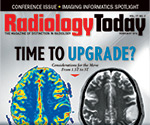 |
You’ve met people who have a natural way of relating to others that puts people at ease and makes them feel heard. I envy such people. While some people have the knack, it is not just a knack. Relating to people also can be learned and practiced as a process. The hospitality industry, among others, understands this concept and uses it to enhance its customers’ experience. Increasingly, health care organizations are adopting to differentiate themselves from competitors and succeed in a value-based reimbursement environment.
— Jim Knaub, editor |
 |
 |
Studying the Patient Experience in Imaging
By Jim Knaub
According to a 2014 paper on patient experience in the radiology department of the MD Anderson Cancer Center published in the Journal of the American College of Radiology, there are differences between what patients and radiologists see as a quality patient experience. For example, in the study’s survey, radiologists considered convenient scheduling, patient comfort, and prompt response to questions to be the key drivers of a positive patient experience. However, patients most valued physicians and staff listening to and acknowledging their concerns and treating them with respect.
Full story » |
 |
 |
Go With the Flow
Using cardiac CT myocardial perfusion as an alternative to SPECT is not a new concept; however, as CT technology has continued to improve, so has the use of this imaging procedure. Read more »
Individualized Screening
When and how to screen women with dense breasts is anything but standardized currently, but some radiologists believe that this uncertainty is a great way to start a dialogue between imagers, referring physicians, and patients to determine the best course of action for screening women with dense breasts. Read more »
IR Coding Changes for 2016
In the second part of Radiology Today’s look at coding changes for 2016, we look at the many changes for the procedure coding of interventional services. Read more »
Time to Upgrade?
According to a 2014 report, the average installed MR system in the United States is 11 years old. With that in mind, many facilities are considering upgrades to separate themselves in a crowded marketplace, resulting in an increase in installation of 1.5T and 3T MRI systems. Read more » |
 |
|
|
 |
“Our study provides the strongest evidence to date that fitness in an older adult population can have substantial benefits to brain health in terms of the functional connections of different regions of the brain.”
— Arthur Kramer, PhD, director of the Beckman Institute for Advanced Science & Technology and a professor of psychology and neuroscience at the University of Illinois on the results of a study that found that the strength of brain connections in older adults varied with fitness level |
 |
|
